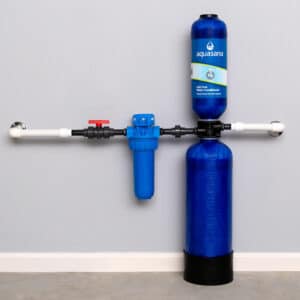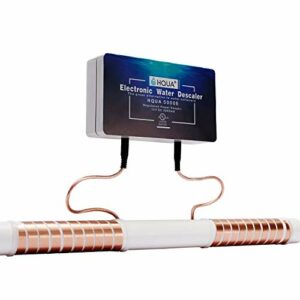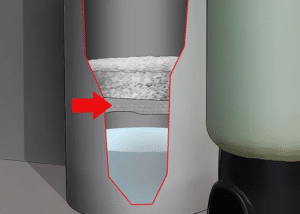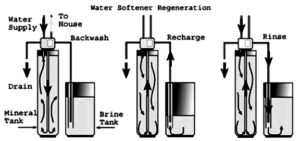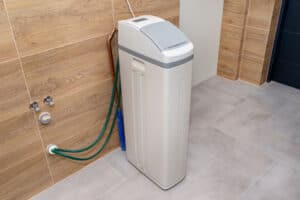Installing a water softener will often require the use of a professional but knowing how to install a water softener on your own is a great way to save you both time and money. Through this article, you will have a good idea of what it’ll take to install a water softener and gauging whether or not you will need a professional.
A water softener is a filtered system that will remove hard minerals such as magnesium and calcium. Without a working water softener, the water that flows through a faucet or showerhead is known as “hard water.”
Use our Free Online Plumber Search Tool to find trusted Water Softener Installers near you.
Water Softener Installation: DIY vs Hiring a Professional
There are two different ways that you can go about installing a water softener. You can choose to install a water softener on your own, or you can hire a professional.
DIY Water Softener Installation
Water softener installation is something that can be done on your own, suppose you have prior knowledge of installation and are generally a pretty handy person. In that case, you may find it in your best interest to do it yourself.
Prior to installing a water softener without a professional, be aware that there are many steps to consider before the process is complete. What kind of water softener you need for your home and general information about pipelines are all information you will want to be well-versed on before attempting the process on your own.
There are other factors to consider, such as where to install a water softener and the water softener installation cost. But once you have all of the necessary knowledge on completing the task, you can save yourself time and money.
However, another aspect to note is that the amount of money you are spending or saving can change drastically depending on the type of water softener you buy. Having prior knowledge of water softeners is important, as you can end up spending more money than necessary on a water softener you don’t need.
- You Can Save Money
- You Won’t Need to Wait for a Professional
- A Lot of Knowledge is Required Beforehand
- You Risk Causing Issues With Your Pipes if Handled Incorrectly
- Installation Costs Vary Greatly
Professional Water Softener Installation
Because of the required knowledge about water pipes and other water softener factors, it is usually in your best interest to hire a professional.
Those who make a living off installing water softeners almost always have a thorough amount of training and experience under their belt. When you hire a professional to install your water softener, you are lessening your chances of either the water softener or another part of your plumbing system breaking.
Many issues can arise from a faulty plumbing system, including low water pressure, an unpleasant smell coming from the drain, and even warping within the floors and walls. To avoid dealing with such issues, it is a good idea to hand over installing a water softener to a professional.
While not every situation will call for a professional (maybe a friend or an uncle has installed a softener before), if you doubt your abilities from the start, it may be for the best that you don’t attempt the process yourself.
Luckily, many companies allow you to hire a professional to help you install the softener. Using our Online Plumber Search Tool, you can start looking for a professional that you can trust in an area near you.
- Hiring a Professional is Easier
- You Won’t Need the Knowledge or Tools
- Hiring a Professional You Trust Will Guarantee a Correctly Installed Water Softener
- You will have to set up a time that is later than you might like
- You will have to pay for the water softener and the installation process
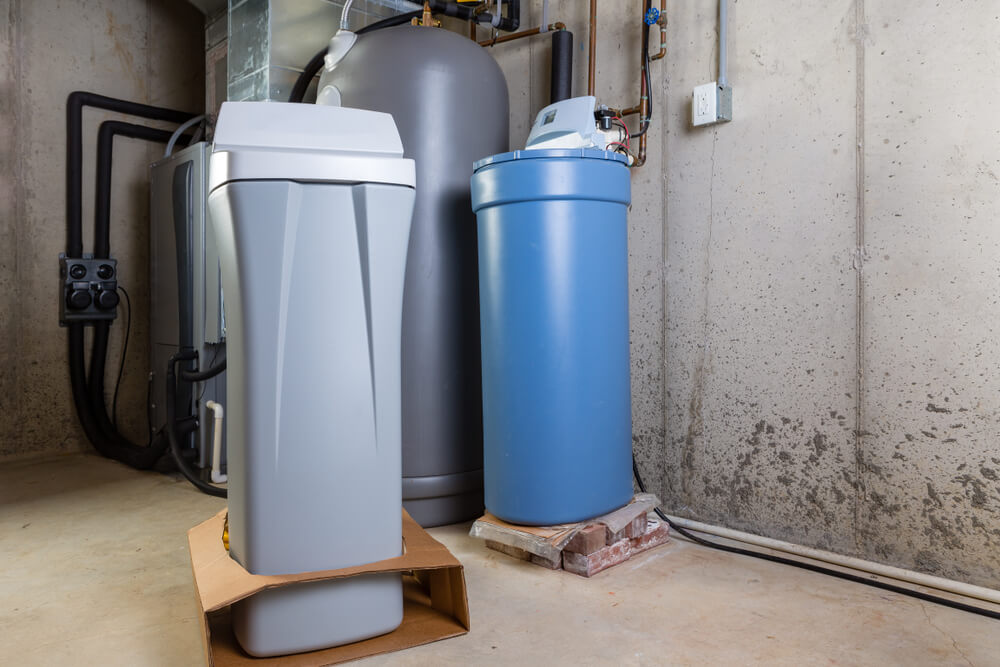
Water Softener Installation Cost
Whether you are installing a water softener on your own or with a professional’s help, there will be costs that come with the process.
DIY Installation Cost
The price of installing a water softener on your own can change wildly depending on the water softener that you buy and the extra tools you will buy to install it.
There are many different types and brands of water softeners, and they all range from $150 to over $2,000 in price. Most homes won’t need an extravagant water softener, just one that will suit the household’s needs. However, the more people in a household, the bigger the water softener will most likely need to be.
Apart from the water softener, if you lack any needed tools during the process, you will have to pay for those as well. Between the softener itself and the tools for the installation, you can end up paying anywhere from $200 to over $2,500.
One of the biggest negatives of installing a water softener on your own is that without the proper knowledge of water softeners, you can end up wasting a lot of extra money. You can accidentally buy a water softener that won’t fit your house and will need to upgrade or downgrade the water softener. Or you can end up accidentally breaking the water softener and will need to spend money on buying a new one.
Professional Installation Cost
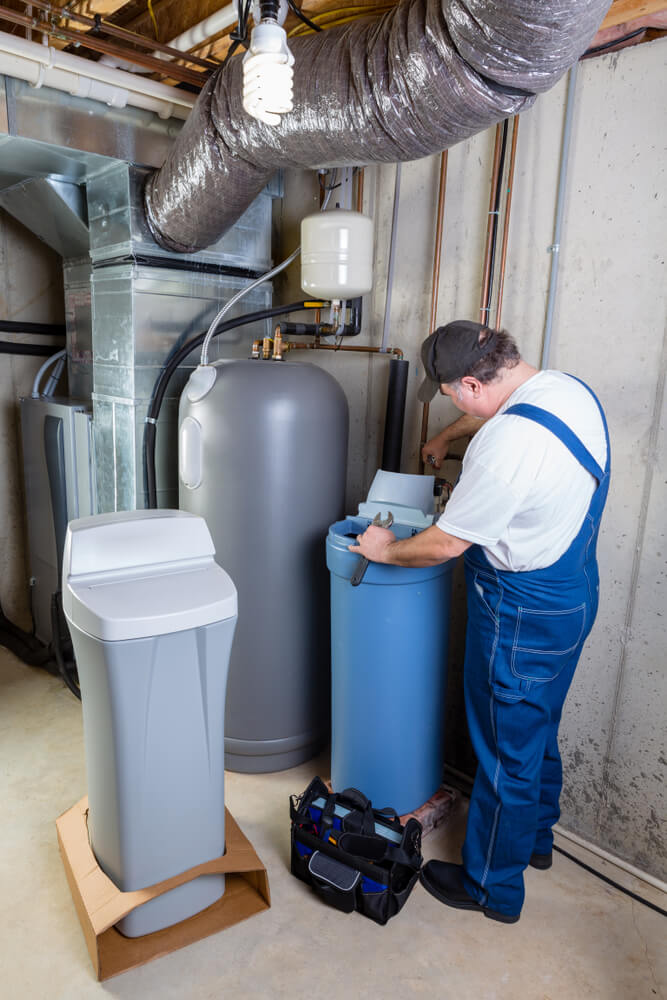
The costs of hiring a professional can end up being more than installing the softener yourself, but by hiring a professional, you will have a fixed price that you can work with.
The costs of hiring a professional can vary on your location and the size of your house. Like with the DIY installation method, you will need a water softener that will fit your household’s size. A bigger household that uses more water will need a bigger and more advanced water softener to match.
The bigger a water softener is, the more you will have to pay, although the price can vary from company to company. Getting professional help can range from $1,000-$6,000, with $6,000 being on the very high end of water softener installation prices. Most of the time, you won’t exceed paying $2,000 for the overall process.
While hiring a professional can cost more money on average, you will often have a set price that you can work around instead of paying more than you were expecting to after shopping for tools to install the softener yourself.
Use our Free Online Plumber Search Tool to find trusted Water Softener Installers near you.
Where to Install Water Softener
If you are going to install a water softener on your own, you will need to know where you will have to place the softener in the household. There are a few different factors that come into picking the right spot for your water softener.
Main Water Source
You will want to install a water softener by the main water pipeline. Installing the water softener by the main water source ensures that all water that passes through the house runs through the filter. Filtering the water at the earliest point in the house will help prevent hard water from passing through.
Power Outlet
You will most likely need to plug your water softener into the wall for it to work, so installing the softener by an outlet will help you out a lot. If you install the water softener too far away, you will have to reinstall it to a location that allows you easily plug the softener into the wall.
Having to reinstall the water softener can cause frustration and waste your money and time overall. Ensure that you check that you can easily reach the outlet with the wire before calling it a day. Ensure that the area you have chosen is dry, as plugging electricity into an outlet in a damp environment can cause safety issues.
Drain
For a water softener to function well, it needs to complete a process called “Regeneration.” Many beads within a water softener soak up the water’s minerals, filter the water, and change it from hard to soft. The process of regeneration involves washing those beads off with a brine solution.
Once the regeneration process is complete, you will need to dispose of the brine solution, preferably through a drain. Any place in your household with a drain on the floor, such as your basement or a water closet, will be a good place to install your softener.
Water Heater
Many people like to install their water softener by their water heaters, as doing so can help keep everything that controls the water function in one localized area.
However, if you are installing a water softener next to your water heater, you should make sure that the softener is at least ten feet away from the heater. If you put the softener too close to the heater, the hot water in the pipes can travel backward into the softener and damage the device.
Overall, you should install your water softener in a dry room that contains a water heater, a drain, an outlet, and as close as you can to the main water source.
Water Softener DIY Installation Process
To install a water softener by yourself, you will first need to obtain the right water softener. There are many different kinds of water softeners, including salt-based and salt-free systems.
There are even water softeners that allow you to change your water’s hardness or softness by varying degrees. Once you have found the correct water softener for your household, you will then need to obtain the necessary tools to install the softener. You will need the following tools:
- A Water Softener
- A Soldering Torch
- Joint Pliers
- A Screwdriver
- A Propane torch
- A Flux and Flux Brush
- Sandpaper
- A Wire Reaming Brush
- Copper Tree
Once you have the necessary tools for the job, you can start to install the water softener. Start by picking out a good location. Once you have chosen the best location, follow the remaining steps.
- Install a bypass valve and shut off your electricity and water.
- After the electricity and water have been shut off, you can start to install your copper pipes and elbows.
- Next, connect your drain hose
- Check your electrical grounding next, and check for any leaks
- Expel air from the water softener
If you are confident that you can pull the job off, but you need a more in-depth look at the process of installing a water softener, or if you need a tutorial, don’t worry.
There are many people in the world who are good at the art of water softener installation. Numerous videos and tutorials are available online that you can use to guide you through the installation process.
Conclusion
Overall, installing a water softener on your own can be easy and a good way to save money provided that you have the tools and knowledge on how to safely install the product.
But installing a water softener in the wrong way will lead to issues arising within your plumbing system, which can cause water to leak from the walls and a bad smell to come from your drains. To avoid any damage from incorrectly installing your softener, hire a professional who will bring you the best experience.
Use our Free Online Plumber Search Tool to find trusted Water Softener Installers near you.

